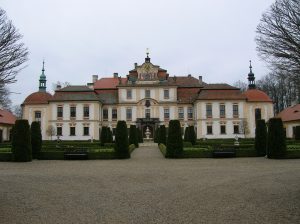Jemniste Chateau
By Tracy A. Burns
Baroque treasure
 Jemniste Chateau near Benesov, about an hour from Prague, is an architectural gem flaunting the Baroque style. It only has eight representative rooms, which is in some respect an advantage as it gives the place an intimate feel. Visitors do not feel overwhelmed, but rather can fully appreciate the magnificent furnishings and fascinating décor. The Main Hall, the Dutch floral Baroque room, and Saint Josef’s Chapel are the highlights of the tour.
Jemniste Chateau near Benesov, about an hour from Prague, is an architectural gem flaunting the Baroque style. It only has eight representative rooms, which is in some respect an advantage as it gives the place an intimate feel. Visitors do not feel overwhelmed, but rather can fully appreciate the magnificent furnishings and fascinating décor. The Main Hall, the Dutch floral Baroque room, and Saint Josef’s Chapel are the highlights of the tour.
History
Thanks to owner Frantisek Adam of the prominent Austrian Trauttmansdorff noble family and architect Frantisek Maxmilian Kanka, the Baroque chateau was completed in 1725. However, tragedy soon intervened, and the residence burned down in 1754. Only the chapel survived the flames. Jemniste was reconstructed in part by leading Czech Baroque painter Vaclav Vavrinec Rainer and first-rate Austrian Baroque sculptor Matyas Bernard Braun, who even designed three sculptural groupings on Prague’s Charles Bridge. At the end of the 18th and beginning of the 19th century, the Baroque garden was transformed into the English park that it is still today.
The Sternbergs come into the picture
The chateau came into the possession of the well-known Sternberg clan when Zdenek Sternberg, also the owner of nearby Cesky Sternberk Castle, purchased it in 1868. The next in line was Filip, the great-grandfather of the current owner and a painter mentored by legendary Art Nouveau artist Alphonse Mucha. It remained in the Sternberg family until 1943, when, during the Nazi Occupation, the clan refused to take German citizenship. The chateau was nationalized under the Communist regime in 1951. The Sternbergs got Jemniste back in 1995, and the current owner, Jiri Sternberg, moved in with his family.
The Sala Terrena
The tour begins in the Sala Terrena, which opens onto the romantic garden. Be sure to look up at the handmade, green, iron chandelier with leaf ornamentation. The two statues of cherubs on the main staircase are the work of master sculptor Braun. The entrance hall shows off engravings of Roman churches and watercolors of the chateaus that the Sternbergs own – Jemniste, Cesky Sternberk, and eastern Bohemia’s Castolovice.
The Main Hall
The Main Hall astounds. The four portraits of Habsburg rulers include a likeness of Emperor Charles VI, who visited the chateau in 1723. Empress Maria Theresa makes an appearance, too. The twisting figures with swirling drapery on the ceiling are the gods of Olympus. Three more frescoes fascinate as well. Pictured on one wall are deities from antiquity – the goddess of wisdom, Pallas Athena; the god of war, Ares; and the goddess of the harvest, Demeter with her daughter Persephone, who is the queen of the underworld. Do not miss the three allegories of the four seasons – autumn, spring with summer, and fall. Check out the cherub gripping the parasol and the figures relaxing in the countryside in the spring/summer rendition.
Discovering Dutch Baroque
The Dutch Baroque floral furniture in the next room is sure to enthrall with its colored woods and engraved decorations. A wooden cabinet features white floral décor. Chairs, a table, a couch, and other pieces of furniture are also decorated in this impressive style. Porcelain from the 17th and 18th centuries is on display, too. Meissen plates with floral themes are featured on the walls. Two Venetian mirrors sport lavish, gold frames. The Bohemian crystal chandelier is breathtaking, too.
Saint Joseph’s Chapel
The only space left intact after the 18th-century fire, Saint Joseph’s Chapel features enticing frescoes. A magnificent ceiling fresco shows the allegories of human characteristics, such as wisdom and fertility. Another fresco, rendered by painting guru Rainer, features the Holy Trinity. The main altar glitters with gold with the crucified Christ taking center stage, the Virgin Mary and Saint John of Nepomuk positioned below him.
Furnishings, Faience, and fans
Other highlights include a Delft Faience, a blue-and-white tiled stove as well as 19th-century Empire, and Mannerist furnishings. Filip Sternberg created an exquisite black fan decorated with the faces of his three children. Other fans are inlaid with pearl and adorned with gold. Filip’s collection of horse paintings is also on display.
Opportunities to stay in the chateau
At the chateau, it is possible to rent apartments decorated with historic furniture. Beds with canopies, fireplaces, and lithographs are just a few of the features of these romantic suites. Weddings still take place in the chapel. A restaurant, café, and shop are also on the grounds. The park includes a rose garden.
Other sights in the Posazavi region
There are many other sights worth visiting in the Posazavi region. It is possible to navigate a boat or raft through the rapids. Hiking, cycling, and horseback riding are a few of the sports the region offers. Gothic Cesky Sternberk Castle with its 15 representative rooms and Konopiste Chateau, where Archduke Franz Ferdinand lived, are nearby, too. Or take a balloon up to 500 meters in the air. In the town of Benesov, there are historical churches and intriguing museums as well as monastery ruins and a Jewish cemetery. Beer lovers can visit the Ferdinand Brewery in Benesov. Other surrounding towns have impressive monuments, too.




